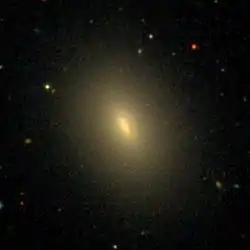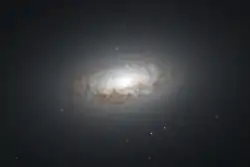NGC 4476
NGC 4476 is a lenticular galaxy located about 55 million light-years away[3] in the constellation Virgo.[4] NGC 4476 was discovered by astronomer William Herschel on April 12, 1784.[5] The galaxy is a member of the Virgo Cluster.[6][7]
| NGC 4476 | |
|---|---|
 SDSS image of NGC 4476 | |
| Observation data (J2000 epoch) | |
| Constellation | Virgo |
| Right ascension | 12h 29m 59.1s[1] |
| Declination | 12° 20′ 55″[1] |
| Redshift | 0.006565/1968 km/s[1] |
| Distance | 55.4 Mly[2] |
| Group or cluster | Virgo Cluster |
| Apparent magnitude (V) | 13.0[1] |
| Characteristics | |
| Type | SA0^-(r)[1] |
| Size | ~31,000 ly (estimated)[1] |
| Apparent size (V) | 1.67 x 1.14[1] |
| Other designations | |
| CGCG 70-128, IRAS 12274+1237, MCG 2-32-96, PGC 41255, UGC 7637, VCC 1250[1] | |
Dust Disk
NGC 4476 has a highly inclined disk of disk that surrounds its nucleus.[8]

Interstellar medium
NGC 4476 is extremely deficient in neutral atomic hydrogen (HI). This may have been caused by a tidal interaction with another galaxy or by ram-pressure stripping caused by the intracluster medium of the Virgo Cluster. Because NGC 4476 appears to lie close to Messier 87, there are many galaxies in vicinity that may have interacted with it. However, optical images of the galaxy show no evidence of an interaction so this unlikely to account for the deficiency in neutral atomic hydrogen.
It is more likely that the deficiency in neutral atomic hydrogen in NGC 4476 is due ram-pressure stripping caused by the intracluster medium as it traveled on a highly radial orbit through the center of the Virgo Cluster. However, at the galaxy's projected distance from Messier 87, the observed ram-pressure stripping exerted on NGC 4476 is not sufficient to cause sufficient effects on the galaxy's interstellar medium. Surprisingly, there is an absence of H I in the inner regions of the galaxy. This may possibly suggest that the physical conditions of the ISM of NGC 4476 are very different from those of typical Virgo Cluster spirals.[6]
See also
References
- "NASA/IPAC Extragalactic Database". Results for NGC 4476. Retrieved 2017-10-08.
- "parsecs to lightyears conversion". Retrieved 2017-09-30.
- "Your NED Search Results". ned.ipac.caltech.edu. Retrieved 2017-10-09.
- Rojas, Sebastián García. "Galaxy NGC 4476 - Galaxy in Virgo Constellation · Deep Sky Objects Browser". DSO Browser. Retrieved 2017-10-09.
- "New General Catalog Objects: NGC 4450 - 4499". cseligman.com. Retrieved 2017-10-08.
- Lucero, D. M.; Young, L. M; van Gorkom, J. H. (13 October 2004). "Ram Pressure Stripping in the Low-Luminosity Virgo Cluster Elliptical Galaxy NGC 4476". The Astronomical Journal. 129 (2): 647–655. arXiv:astro-ph/0410424. doi:10.1086/426750. S2CID 11491646.
- "Detailed Object Classifications". ned.ipac.caltech.edu. Retrieved 2017-10-09.
- Young, L. M. (8 May 2002). "Molecular Gas in Elliptical Galaxies: Distribution and Kinematics". The Astronomical Journal. 124 (2): 788–810. arXiv:astro-ph/0205162. Bibcode:2002AJ....124..788Y. doi:10.1086/341648. S2CID 13963035.
External links
| Wikimedia Commons has media related to NGC 4476. |
- NGC 4476 on WikiSky: DSS2, SDSS, GALEX, IRAS, Hydrogen α, X-Ray, Astrophoto, Sky Map, Articles and images